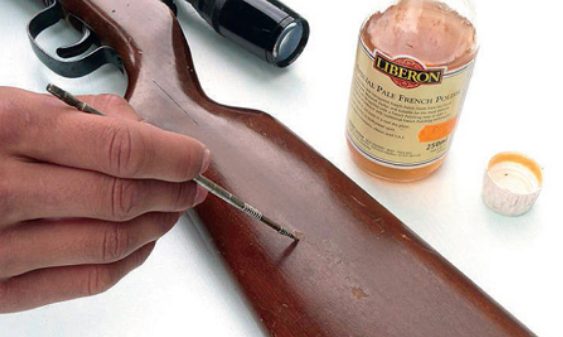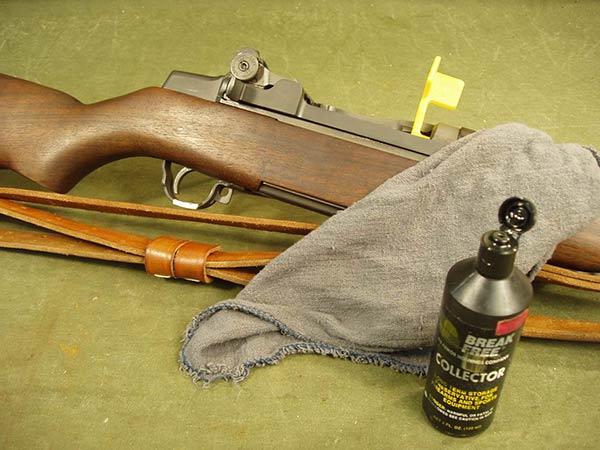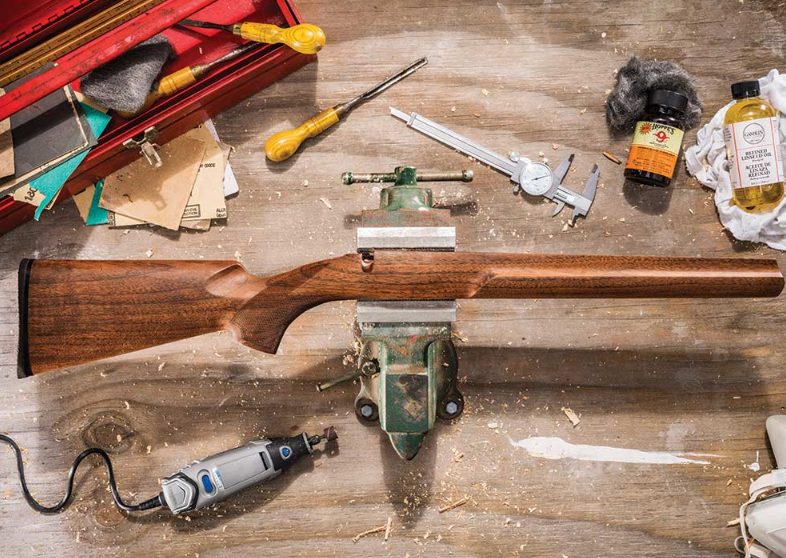
Welcome to our detailed guide on refinishing gun stocks for a stunning and enduring finish. This article is your go-to resource, whether you’re a seasoned gun enthusiast or a beginner in firearm maintenance. We delve into the nuances of restoring the aesthetic appeal and durability of your gun stock, a critical component as it’s the part you grip when aiming and firing. We’ll walk you through the entire process of finishing a rifle buttstock, discussing the necessary materials and providing a comprehensive, step-by-step approach to refinishing your gun stocks like a professional.
The process of refinishing isn’t just about aesthetics; it’s about preserving the strength and integrity of the stock. We cover everything from the initial steps of removing the old finish – be it through chemical stripping or sanding – to choosing the right type of finish for your specific needs. The guide ensures you’re well-equipped with all the materials you need, such as various grits of sandpaper, wood preservatives, degreasers, wood stains, finishes like Tru Oil, wax, gauze, tools, and essential protective gear like gloves and eye protection.
Safety is paramount in our guide. We emphasize the importance of ensuring the firearm is unloaded before commencing the refinishing, removing the action from the stock to prevent damage during the process, and adhering to all manufacturer’s safety instructions. We also discuss working in a well-ventilated area to avoid harmful fumes from sanding and stripping, along with other precautions to ensure a safe refinishing experience.
By the end of this article, you will have gained all the knowledge needed to give your gun stock a new lease on life, with a beautiful and durable finish that stands the test of time. Whether you’re restoring a shotgun buttstock or a rifle stock, our guide caters to a range of firearms, ensuring your efforts result in a finish that’s both visually pleasing and long-lasting.
Can a shotgun buttstock be restored?

It depends on the condition of the shotgun buttstock. If the finish is in bad shape, then refinishing might be the best option.
The refinishing of a gun stock is not difficult, but does require some basic knowledge and skills.
The first step is to remove the old finish. This can be done with a chemical stripper or by sanding.
If you are going to use a stripper, be sure to read the manufacturer’s instructions carefully and follow them closely.
There are many different types of finishes available, so it is important to choose one that is right for your particular needs.
With a little time and effort, you can refinish your gun stock and give it a new lease on life.
With the right materials and a little patience, you can achieve a beautiful, durable finish that will last for many years to come.
Material needed for the job

You’ll need to gather a few supplies before starting the refinishing process:
- Sandpaper (grit 150 – 400)
- Wood preservative
- Degreaser
- Wood stain
- Tru Oil
- Wax
- Gauze
- Tools
- Protective equipment (gloves, eye protection)
Now that you have gathered all of the necessary materials, you are ready to refinish your gun stock!
Safety rules for rifle buttstock finishing
- The gun must be unloaded
This should go without saying, but always make sure that the gun is unloaded before refinishing the stock.
Remove the action from the stock (if possible) to avoid damaging it during the refinishing process.
Make sure that there is no ammunition in the gun or in the vicinity.
Do not try to refinish a gun stock while it is attached to the firearm.
Always remove the action from the stock before refinishing.
This will protect both you and the firearm from potential accidents.

- Be sure to read and follow all manufacturer’s instructions carefully.
- Wear gloves, eye protection, and a respirator when refinishing a gun stock.
- Work in a well-ventilated area. Sanding and stripping can produce harmful fumes.
- Avoid exposure to the fumes by working in a well-ventilated area or wearing a respirator.
- Take precautions to avoid flying debris when sanding, such as wearing safety glasses.
- Wear gloves to protect your hands from chemicals and stain.
- Gather all materials before starting the refinishing process.
- Have everything you need within reach so that you can work quickly and efficiently.
The process of finishing a rifle buttstock:
Basic steps for finishing a shotgun buttstock:
- Remove the old finish
- Sand it
- Apply a new finish
Disassemble firearms for refinishing

The first step in refinishing a gun stock is to disassemble the firearm.
This will allow you to access all of the parts that need to be refinished.
If possible, remove the action from the stock. This will protect it from damage during the refinishing process.
Remove the action from the stock and set it aside in a safe place.
Next, remove all of the hardware from the stock. This includes the trigger, trigger guard, and any other detachable parts.
Be careful not to lose any small parts during this process.
Once the stock is disassembled, you can begin stripping the old finish.
Remove the old finish from the buttstock
The next step in refinishing a gun stock is to remove the old finish.
This can be done with a chemical stripper or by sanding.
If you are going to use a stripper, be sure to read the manufacturer’s instructions carefully and follow them closely.
Sand the stock

Once all of the hardware has been removed, sand the stock.
You will need to start with a coarse grit paper and work your way up to a finer grit.
Be sure to sand evenly to avoid damaging the wood.
You can use a hand sander or a power sander for this task.
Once you have sanded the stock, you will need to remove all of the dust with a damp cloth.
Be sure that thestock is completely free of dust before moving on to the next step.
This will remove any old finishes and prepare the surface for refinishing.
Degrease the stock
After sanding, clean the stock with a degreaser to remove any dirt or oils that may be on the surface, that might prevent the new finish from adhering properly.
There are many different types of degreasers available, so be sure to choose one that is right for your needs.
You can use a commercial degreaser or a simple solution of soap and water.
Apply the degreaser to the stock and allow it to dry completely.
Once the degreaser has dried, you can begin sanding.
Apply a wood preservative
Once the stock is clean, apply a wood preservative to help protect it from moisture and pests.
Let the preservative dry completely before proceeding to the next step.

Repair any cracks or damage
The step in refinishing a gun stock is to repair any cracks or damage.
This can be done with a wood filler or epoxy.
Be sure to follow the manufacturer’s instructions carefully and allow plenty of time for the filler or epoxy to dry completely before proceeding to the next step.
After the filler or epoxy has dried, sand the stock again.
Staining

Once the stock is degreased, you can begin staining it.
Staining the stock will give it a new color and help to protect it from damage.
Be sure to choose a stain that is compatible with the type of finish you want to use.
After applying the stain, allow it to dry completely before proceeding to the next step.
Apply a finish

The final step in refinishing a gun stock is to apply a finish.
This will protect the wood and give it a beautiful shine.
There are many different types of finishes that can be used, but Tru Oil is a good option for gun stocks.
To apply the finish, simply wipe it on with a clean cloth and allow it to dry.
Allow it to dry for at least 24 hours before applying another coat.
Repeat this process until the desired results are achieved.
Once you are satisfied with the finish, apply a thin layer of wax to protect it from damage.
Once the finish is dry, you can reassemble the firearm.
FAQs
1. How long does refinishing a gun stock take?
The process of refinishing a gun stock can take anywhere from a few hours to a few days, depending on the condition of the stock and the type of finish you are using.
2. What type of finish should I use?
There are many different types of finishes that can be used on gun stocks. Tru Oil is a good option for gun stocks.
3. How do I apply the finish?
To apply the finish, simply wipe it on with a clean cloth and allow it to dry. Allow it to dry for at least 24 hours before applying another coat. Repeat this process until the desired results are achieved.
4. Can a synthetic buttstock be restored?
Yes, a synthetic buttstock can be restored. The process is the same as refinishing a wood stock.
5. Does the stock have to be oiled?
No, the stock does not have to be oiled. You can apply a finish of your choice to protect the wood and give it a beautiful shine. However, if you do choose to oil the stock, be sure to use a compatible oil with the type of finish you are using.
Conclusion

Refinishing a gun stock is a great way to protect your investment and keep your firearm looking its best.
The process is not difficult, but it does take some time and patience.
With some basic tools and materials, you can refinish your own gun stock at home and save money in the process.
By all these steps, you can achieve a beautiful, durable finish that will last for many years to come.
Be sure to follow the manufacturer’s instructions carefully and allow plenty of time for each step to dry completely before moving on to the next.
Once you have completed the refinishing process, your gun stock will be ready for years of use.
Thanks for reading! I hope this article was helpful.
